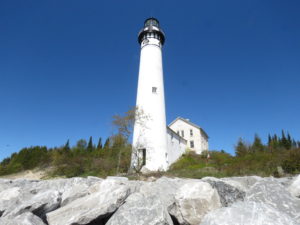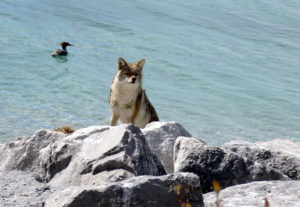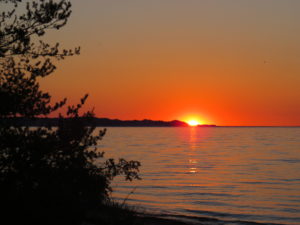By David Fleet
Editor
Leland-From shipwrecks to rescuing hikers to a coyote neighbor—Jonathan Schechter’s summer days on a tiny Lake Michigan island are anything but mundane.
From May 24 until July 1 Schechter, a Brandon Township resident served as the lighthouse keeper on South Manitou Island. Each summer since 2016 Schechter was one of three individuals selected by the National Park Service for the month-long stint to run the working maritime feature on northeastern Lake Michigan, about 7 miles off the coast of Leland—part of Leelanau County and the Sleeping Bear Dunes National Lakeshore. The small island is about 3 miles by 3 miles in size and features Florence Lake along with a system of trails and campsites. The

island is accessible by the Manitou Island Transit from Leland that makes the trip over and back during the summer months.
“After four years on the island, I’m still learning something new,” said Schechter an on-call firefighter/paramedic for Brandon Fire Department, contingent ER Paramedic for McLaren and an Advanced Wilderness and Expedition Provider, the highest wilderness certification offered.
Schechter’s job as lighthouse keeper is to greet the boats when they would come in each day and take people up in the lighthouse if they wanted to climb up to the top. “Many came out here just to see a Great Lake lighthouse,” he said. “There are 117 steps that turn around a center pole to the top. Going up was not bad, but coming down some had difficulty.”
“The island is physically changing all the time, the shoreline moves,” he said. “It’s truly dynamic. The water in Lake Michigan was extremely high this summer, which created some challenges for the island life and those who visited.”
The water level in Lake Michigan and Lake Huron, which rise and fall as one, is at a high not seen since the late 1990s, according Lauren Fry, the Detroit office of the U.S. Army Corps of Engineers.
At about 7 a.m. on Schechter’s first full day on the island, the Benzie County Sheriff reported three men and a women trapped near the lakeshore.
“We did a hasty search,” said Schechter.
The hikers were found by p

ark rangers along with Schechter between a steep bluff and Lake Michigan. The group had attempted to hike around the shoreline of the island, however due the high water level were stranded near the shoreline. They four were extracted by a rescue boat from the cliff and received only minor injuries.
“They were very cold and grateful, while a little embarrassed,” he said.
The small island is significant in Michigan history due to a unique natural deep water port known as Crescent Bay—the only such feature between Chicago and Buffalo, NY. So important is the location that in 1838 Congress OK’d $5,000 for the construction of the first lighthouse to help ships navigate the often turbulent waters of the Manitou Passage.
In 1871 a second lighthouse was built due to the shipping traffic and the number of wrecks in the area. The 100-foot lighthouse, which according to the Sleeping Bear Dunes National Lakeshore historians is 18 feet in diameter at the base, was in full operation until 1958.
“Due to the high water many bits and pieces of old shipwrecks are now scattered on the shore line,” he said. “There’s an estimated 50 shipwrecks nearby so it’s no wonder why so many items end up on the island.”
Schechter related an rather unique encounter on the island:
On day three of my most recent stay I encountered my old friend, “Brother Coyote,” a handsome fellow indeed, one I had become familiar with during the closing days of my previous tour as he would feast on strawberries near the bay. I saw that coyote at relatively close range more than a dozen times during my most recent stay, and on a few occasions we were just separated by about 40 feet. Some of the encounters were during the day, others towards dusk. I am certain, based on tracks observed in the sand, that he saw me many more times than I saw him, without me being aware of his presence. I am also convinced he came to know my behavior very well because we shared the same su rroundings and our paths crossed frequently for I was living in his hunting and foraging habitat. Early one morning a few days later I watched the coyote from the lighthouse catwalk as he walked the shoreline apparently feasting on alewives that washed ashore the night before
rroundings and our paths crossed frequently for I was living in his hunting and foraging habitat. Early one morning a few days later I watched the coyote from the lighthouse catwalk as he walked the shoreline apparently feasting on alewives that washed ashore the night before
The most dramatic encounter – which I will always cherish – occurred my third week while I sat on the steps to the entrance of the lighthouse. I was casually watching the Herring Gulls that build their nest on the breakwall when suddenly the gulls sounded alarm calls and took flight as a female Common Merganser paddled away from the breakwall. Seconds later, the coyote emerged from the water side of the breakwall and climbed up to the closest gull nest. With what seemed like an extraordinary amount of care, he took an egg in his mouth. He spotted me as I raised my camera, gave me a passing glance and trotted down to the end of the breakwall and then into the woods to enjoy his breakfast treat. I was delighted at his slow retreat, for it told me that he did not consider me a threat, but just a human to be wary and watchful of when it was time for his morning omelet.
